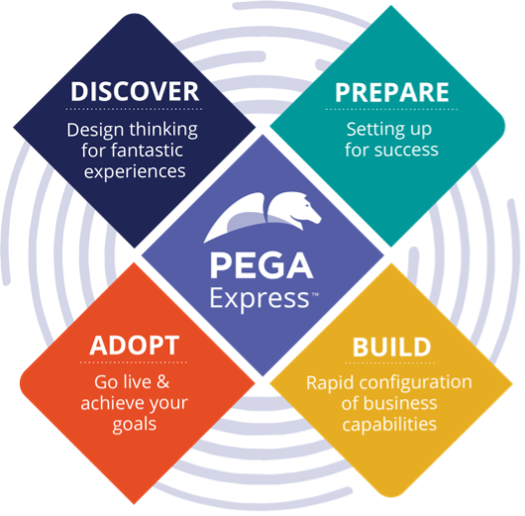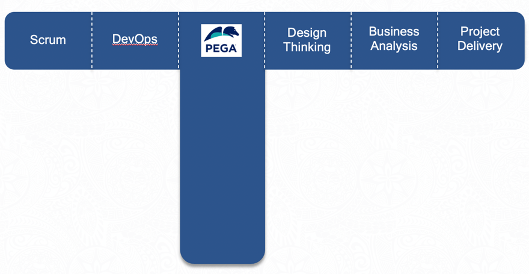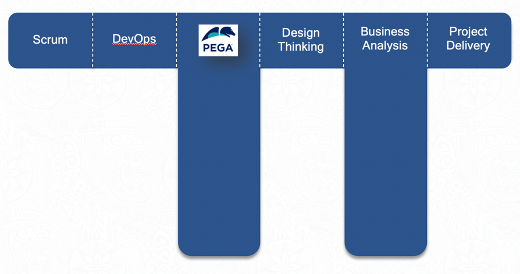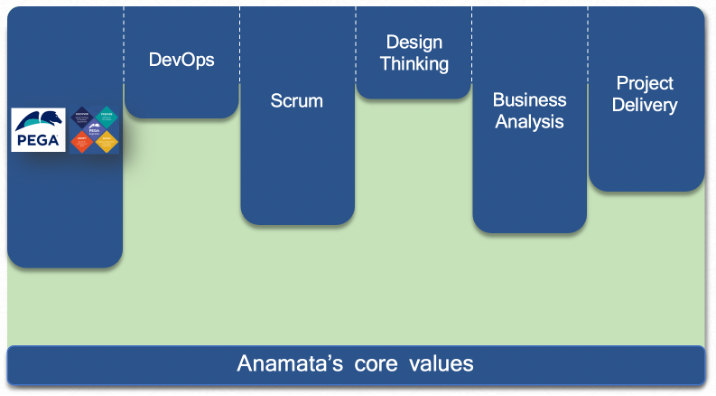As Pega continues to deliver innovative software that crushes business complexity, challenges are on its path. A big promise of low-code platforms like Pega is to facilitate fast delivery of great new features to enhance an organization’s business. However, fulfilling this promise can be quite a challenge, because the time spent on actual “building” is drastically reduced. This relatively increases the impact of aspects like business analysis, design, release management and operations. In addition, these aspects have become more and more intertwined in agile, low-code endeavors.
These challenges require a rethinking of both the software delivery process and the optimal skills of a Pega Architect: Pega Express™ and Anamata’s M-shaped profile.
Pega Express™
Having a low-code platform, capable of creating customer-centric journeys, it is key to identify the stakeholders of that journey and include these stakeholders in the delivery process.
To optimize the collaboration between a Pega delivery team and the business stakeholders, it is important to have a way of working in place. This way of working should optimize the amount of time spent on identifying processes, determining requirements, validating the MLP[1] and giving feedback during the process. Additionally, all delivery team members should be aware of the importance of the way of working and have the ability to execute.
Pega developed a methodology to describe this way of working, Pega Express™. It is, in their own words, “A light, design-focused delivery approach that uses Pega’s low-code experience, best practices and scrum to deliver meaningful outcomes quickly.“
To deliver the right things fast, the focus should be on the definition of these right things, based on the business outcome. With the desired business outcome in mind, the most valuable journey(s) can be determined. The focus should be on one MicroJourney™ at a time, creating MLPs that include these journey(s).

Focus on business outcomes
Anamata believes that the key to a successful delivery process is a relentless focus on the business outcomes. This focus on what an organization wants to achieve with a technological solution, should be present in each and every phase of the delivery. As a result, all people involved in a project will know the considerations and decisions that are being made from a business perspective. This will encourage all to focus on the outcome and be aware of any deviations.
Having the Business Outcomes as common goal not only helps to maximize the effectiveness of everyone’s contributions. It is also highly motivational to
- be heading in the same direction as one team,
- understand the reasons behind decisions,
- see the progress made towards that goal.
Building it right doesn’t mean you’re building the right thing. Therefore, at Anamata, we believe that every member of a delivery team should not only know the desired business outcomes but also the elements comprising the Pega Express™ methodology. Team members do not have to be an expert in everything, but they should at least have a basic knowledge of all the aspects involved, while keeping focus on their strengths.
T-shaped profile: 1 expert skill
How do we approach that at Anamata? Many will know about the so called T-shaped profile, to describe a person’s skills. The vertical bar on the letter T represents the depth of related skills and expertise in a single field, whereas the horizontal bar is the ability to collaborate across disciplines with experts in other areas and to apply knowledge in areas of expertise other than one’s own.
The T-shape in the following picture shows an example of a T-shaped Pega Architect.

The figure above shows the skills of a Pega Architect, with in-depth knowledge of Pega and basic knowledge of some other methodologies used in a project. However, the architect does not have enough knowledge of taking over the tasks of a — for instance — scrum master. When this architect takes over the tasks of a scrum master, there is a possibility that the positive effects of scrum vanish. Simply because the architect doesn’t have enough scrum knowledge.
While setting up collaborative multidisciplinary teams, this T-shaped metaphor is used a lot. Unfortunately, this is a limited representation of the core skills needed to be a top-notch Pega team member.
Pi-shaped profile: 2 expert skills
That is why it is better to define Pega team member skills in terms of Pi, or π. In contrast to the T- shape, the pi-model (π -model) has not one, but two vertical bars, meaning that a person has deep knowledge in two different aspects in the Pega express™ methodology.
Apart from increasing versatility, having pi-model experts in your team will have some great additional benefits, as it helps to:
- create a better understanding between team members,
- improve collaboration,
- reduce the chance of a single point of failure.

These benefits not withstanding, in our own journeys we have experienced that this profile does not fit everyone. Of course it is perfectly fine if someone wants to have expertise in two different aspects. But what if someone else wants to have in-depth knowledge of one aspect and wants to know more about two or more others? Should we reject that? Should we prevent people from developing themselves in what they want, professionally?
Professional curiosity should be nurtured as much as possible. So, we created a new model, supporting curiosity and mastery. We call it the M-model.
Anamata’s M-model: the skills of an Anamateer
Anamata’s M-model is focused on, but not limited to, Pega Express™. The horizontal bar reflects these Pega Express™ skills and Anamateers should have (or gain) basic knowledge of all these aspects. In addition to this basic knowledge, the Anamateer should have (or develop) Pega System Architect skills. The most left vertical in the figure below reflects the skills and shows the profile of a PCSSA (Pega Certified Senior System Architect). And, while the architect can of course extend their knowledge in Pega, Anamata believes that the architect should be able to broaden their knowledge by exploring any of the other aspects.

As mentioned, the horizontals could represent more aspects than Pega Express™. If we find another methodology, tool or aspect important enough to include in our skillset, we could include this in the horizontal bar.
Anamata’s core values
An important supporting factor in the M-model, are the Anamata core values. Anamata’s core values support the hard skills of top part of the M-model. The values reflect the Anamateer’s soft skills and personality, which we explain here.
M-shaped teams
As stated in the introduction, with the reduction of the time spent on actual building on a low-code platform, mastery of the other disciplines becomes increasingly important to guarantee fast delivery of useful features. These disciplines include business analysis, design, release management and operations. And as these disciplines have become more and more intertwined, it becomes ever so important that team members are not just able to take over some work from an other discipline, but master more than one discipline at a sufficient level to easily collaborate with each other, and be able to challenge and stimulate each other.
By utilizing the M-model, Anamateers are multidisciplinary and fulfill a prominent role in multidisciplinary, M-shaped teams. The total skillset of the team should equal all expert levels on every aspect of the Pega Express delivery methodology.
Are we there yet? No.
Are we getting there? Definitely.
Because we develop the future. Today.
[1] MLP is Pega’s version of the Minimum Viable Product (MVP): Minimum Loveable Product.
Pssst. Want to help us in creating that M-shaped team? Click here to see our job openings

